Baltic Sea
Mail Routes
The first proof of a mail line crossing the Baltic Sea is reported from the year 1680. A study by Wolfang Kramer, Reinhard Kramer and Horst-Dieter Foerster described the route from Stralsund, Prussia, to Ystad on the southern coast of Sweden operated by sailing-vessels, dependent on wind and weather. Less endangered was the route via the islands of Denmark, used for mail transport in the 17th century, too. A substantial amelioration came in the 19th century on Swedish initiative, however with three decades delay compared to the Channel. Mail-steamers replaced the sailing-vessels on the route Stralsund - Ystad in 1864, changed to Malmo in 1866, connecting with the new railways Berlin - Stralsund and Malmo - Stockholm. Kramer / Foerster mentioned the paddle-wheelers "Oskar" under Swedish and "Pommerania" under Prussian flag, opening the service in 1864. When in winter the route was blocked by ice, the mail was rerouted via Denmark. In the 1870s the Rostock-Nykoebing-Dampfschiffahrts-Aktiengesellschaft operated between Germany and Denmark, later the Deutsch-Nordischer Lloyd. The first so-called 'Salondampfer', saloon steamers, were the "Rex" of Rederi AB Sverige-Kontinenten and the twin-funnel "Imperator" of J.F. Braeunlich, used from 1897 on the new mail route from Sassnitz on Ruegen island to Malmo. In 1903 the Nykoebing route and in 1909 the Malmo steamers were replaced by train ferries - see the relevant chapters.
Development of steamer services to Finland (described by Bruce Peter: Baltic Ferries) started already in 1821 with the paddle steamer "Stockholm", introduced on the Stockholm - Turku route by Samuel Owen, ending after seven seasons. In 1836 the Turku S.S.Co. (Abo AB) commenced services from Turku to Stockholm and later also to Tallinn, Kronstadt and St. Petersburg. Seasonal Gulf of Bothnia routes, emigrant services by Thingvalla Line and a short-term Stockholm service, introduced by Karl Korsman, the founder of Turku shipyard, were to follow. In 1884 the Turku Steamship Co., founded by Captain Lars Krogius, started a Helsinki - Hull service with the "Sirius", what meant the beginning of traditional Finska Angfartygs Aktiebolaget or FAA. In 1898 Angfartygs AB Bore opened a Turku - Stockholm service.
One of the companies with the longest tradition is the Forenede Line of Denmark, founded in 1866 by Carl Frederic Tietgen, known also as the United S.S.Co. or simply DFDS. In the time before WWI, Bradshaw's timetable listed, apart from local routes, steamer services of the Wilson Line from Hull, England, to Gothenburg, Riga and St. Petersburg, the capital of the Tsars, John Good & Sons Hull - Helsinki - St. Petersburg, British & Northern Shipping Agency London - Stockholm, Swedish Mail Steamers Luebeck - Gothenburg, Hallandsche Steamers Luebeck - Malmo, Finland Line Hull-Helsinki, Finland S.S. Co. Stockholm - Helsinki and Stettin - Helsinki, DFDS London - St. Petersburg via the Kiel Canal and Hanseatic Co. Luebeck - St. Petersburg. In the late 19th century the Finland Steamship Co. provided also services Stockholm - Helsinki - St. Petersburg. Bradshaw's timetable of 1914 listed St. Petersburg services by the United Shipping Co. and by Wilson Line. For London routes, including the St. Petersburg Express Line of Russia, see chapter North Sea.
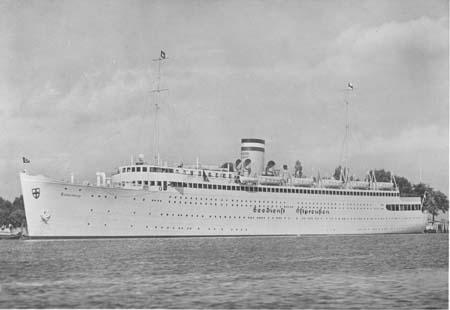
"Tannenberg" of Hapag-Seebaederdienst for Seedienst Ostpreussen (old card, coll. WS)
|
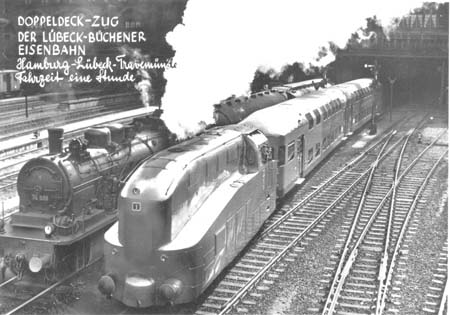
Connection Hamburg - Travemuende in the 30s (old card, coll. Josef Ungewitter)
|
Between the Wars
With the peace negotiations after World War I, it was decided to restore the Polish state. The new republic was conceded an access to the sea to the debit of German territory. The so-called Polish Corridor separated Germany's province East-Prussia from the mother land. Although Germany was granted free transit by railway and road, passengers and goods were subdued to severe control by the Polish authorities. When in 1920 a German delegation travelled to Moscow, they had to take the ship to Tallinn, the capital of Estonia, for Poland was fighting a war on Russia. On that reason the German government initiated in 1920 the Seedienst Ostpreussen of Hapag-Seebaederdienst for a link between Swinemuende and Pillau, connecting with trains from Stettin and to Koenigsberg, thus circumventing the "corridor". Later the government-supported service operated with the modern double-screw motor-ships "Preussen" and "Hansestadt Danzig" of 2,282 tons, delivered from the Oder Werke of Stettin in 1926. They conveyed 1,158 passengers and 32 motorcars overnight at a speed of 16 knots. In 1934 the train ferry "Preussen" of the Trelleborg route was chartered for a short time (according to historian Friedhelm Ernst). In 1935 the 5,504-ton turbine steamship "Tannenberg", designed for a speed of 18 knots and a capacity of 2,000 passengers and 100 motorcars, was delivered from Oder Werke. She sailed from Travemuende via Warnemuende, the seaside resorts of Binz, Swinemuende and Zoppot (near Danzig) to Pillau and Memel, annexed by Lithuania, named Klaipeda. Occasionally the service was extended westward to Kiel and eastward to Helsinki. The ships of the Seedienst Ostpreussen, which carried this name in big gothic letters midships, were kept in the ownership of the German Ministry of Transport and managed by Hapag. After the occupation of Poland in 1939 the operation was shut down and the ships were handed over to the navy. All three ships sank in 1941 as minelayers near Oland running into a Swedish minefield.
Coastal steamers connected Cranzbeek in East Prussia with Memel. In the meantime, Lenin had started the first prosecution of Russian intellectuals, who escaped from communism aboard the German steamer "Oberbuergermeister Haaken", arriving at Stettin in 1922. A service from Stettin to Tallinn and Helsinki was maintained by RCG (R.C. Griebel) of Stettin. Quite another purpose had a temporary service of the Holland-Amerika Lijn with the little steamer "Warszawa". She carried Polish migrants from Danzig to Rotterdam, where they changed to an ocean liner.
During WWI Finland achieved independence from Russia, but the war had decimated its fleet. Rederi AB Svea of Stockholm re-opened in 1918 services services to Helsinki, cooperating with the Finland S.S.Co. (FAA) and Bore Line. Later also other services were provided by the Finland S.S.Co. between Hull, Antwerp, Stettin, Gdynia, Tallinn and Finland, by John Nyrminen between Helsinki and Tallinn, by Bore Line between Luebeck and Turku and by minor companies. Traditional connection between Hamburg and Lubeck was the privately-owned Luebeck-Buechener Eisenbahn. For Sovtorgflot services to London see chapter North Sea.
Before the outbreak of World War II, the German timetable listed e.g. in 1939 the Finland S.S.Co. services from Antwerp via the Kiel Canal, from Hull and from Stockholm to Helsinki and a Tallinn - Helsinki route, proclaimed for travellers from Berlin in connection with trains, Bore Line and Svea Stockholm - Helsinki, RCG Pillau - Helsinki, Neptun Hamburg - Riga, DFDS Frederikshaven - Gothenburg and Oeresund of Denmark on the short route Copenhagen Havnegade - Malmo.
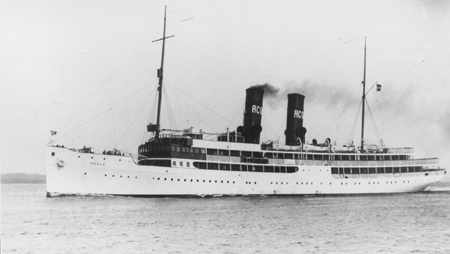
"Ruegen" of RCG, Stettin - Reval, 1936 (Wilhelm Tausche)
|
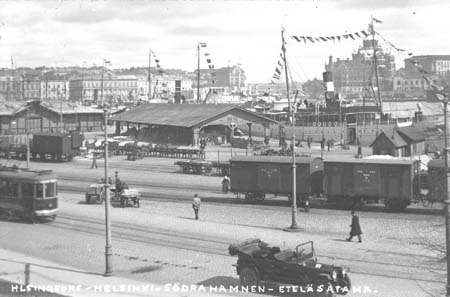
Helsinki before WWII (old card, coll. WS)
|
WWII and Aftermath
Everything came to an end when Hitler started World War II by invading Poland in September 1939. With the Hilter-Stalin agreement in the same year the Baltic states were annexed by the Soviets and thousands of refugees had to be conveyed to Germany by a fleet of local steamers and also German ocean liners. The Soviets provoked war on Finland in 1939 and in 1944 an armistice was achieved. In January 1945 the Soviet Army conquered East Prussia and those Germans who could leave the city of Koenigsberg by the last trains had saved their life. A wonderful lady told the story of her mother, who left her suitcase on the platform only to escape together with her daughter, then a little child. After the Soviets had encircled the city, the last refugees could leave only by the way of the Baltic Sea. About 9,000 went down with the "Wilhelm Gustloff", a former cruise ship, and 7,000 with the "Goya", a former Norwegian cargo ship, when they were torpedoed by the Soviets. And 3,000 people died after the former cruise ship "General von Steuben" had hit a mine. Nevertheless many thousands of people were saved by ship.
After the war, in late 1945, the ex-German train ferries "Sassnitz" and "Preussen" of the Sassnitz - Trelleborg route were used under British command for repatriation of Polish citizens by the way of Luebeck - Gdynia. A Swedish train ferry, the "Drottning Victoria" was employed in winter 1945 on non-public cargo and support services between Trelleborg and Gdansk, the former Danzig, now Polish. With the
Russian victory, Poland and the Eastern part of Germany were occupied by the Soviets, while the Baltics and Koenigsberg, now Kaliningrad, were annexed by the Soviet Union. Though Swedish railways SJ started passenger train ferry services to Poland already in spring 1946 (see the relevant chapter) development of traffic to the Soviet sphere was hampered by the Cold War.
Shipping services in the west had a better chance to develop. After WWII, FAA started Copenhagen - Helsinki services with the "Ariadne" of 1914. Like the "Aallotar", she had been confiscated by the Soviets, but during the transfer to Leningrad she ran aground and then she re-entered FAA.
Cooks Continental Timetable listed e.g. in 1958 two to three daily departures from Stockholm to the Finnish ports of Turku or Helsinki by Finland Line (FAA), Bore Line and Svea Line with steamers of 1,500 to 2,990 tons. In 1949 DFDS started services Copenhagen - Helsinki in cooperation with Finland Line. When Helsinki was closed by ice, the steamers called at Hango or Abo.
Of course there were many local and island services, mainly around Denmark. The Gothenburg-Frederikshavn Line was connected with Hamburg by the train Nordpilen. The Luebecker Linie provided a seasonal service Travemuende - Copenhagen - Helsingborg. Much more dominant were the train ferries - see the chapter Passenger Train Ferries. One of them, the ex-German "Mecklenburg", transferred to the Soviets and then to Poland as "Kopernik", was employed for some time before 1948 on a route Gedser - Gdynia (according to F.Ernst). North Sea routes to Poland were maintained only with passenger-cargo steamers of Polish Ocean Lines and the United Baltic Corp. Ltd. between London or Hull and Gdynia/Gdansk. Not any service to the Soviet territories was listed.
Car Ferries
Already from the 1920s some train ferries had been equipped to carry motorcars, too. In the 50s Cook's timetable mentioned also the motor ferry "Peter Wessel" (of 1937), carrying 620 passengers and 70 cars, of A/S Larvik-Frederikshavnferjen. Some ships carried motorcars, being loaded by crane. With the jet age, international rail passenger traffic did almost completely disappear towards the end of the 20th century and the car ferries are dominating the market. Among the early car ferries, built in the late 50s (listed by Curt Frick), were the "Prinsessan Christina" of Sessan Linjen, the "Skagen" of the Kristiansand Dampskipsselskabet and the "Gripen" of Svenska Rederiaktiebolaget, all employed in the seas surrounding Denmark. Listing all the companies and their significant ships would go beyond that survey. One smaller Swedish company however should not be failed to notice: It's Linjebuss or LB, which provided, apart from car ferries Helsingborg - Helsingoer, in the 50s 1st-class bus lines to Rome, Nice and Paris. For the history of all the Baltic Sea routes, including short-haul, the extensive literature is recommended, e.g. 'Faehrschiffahrt der Welt' by Kai Ortel / Horst-Dieter Foerster, 'Baltic Ferries' by Bruce Peter (Ferry Publications, Ramsey 2009), the German magazines 'Schiffahrt international' and 'Ferries', the Web sites wikipedia.org and other ones.
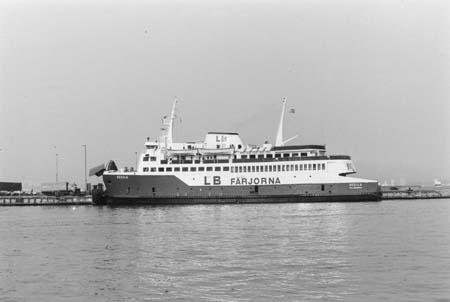 "Regula" of Linjebuss Intl. AB, Helsingborg 1978 (WS)
"Regula" of Linjebuss Intl. AB, Helsingborg 1978 (WS)
To and from Sweden
In December 1962 Sten A. Olsson had founded the Skagenlinjen, starting a ferry service from Gothenburg to Denmark with four vessels, bought second-hand. Re-named Stena Line, the company opened the Kiel - Gothenburg route in 1966 and swallowed in 1981 its competitor Sessan Linjen and also Lion Ferry. Four 25,000-ton ferries had been ordered in Poland, but due to political troubles only two of these 'Jumbo' ferries, the "Stena Germanica" and "Stena Scandinavica", were delivered in 1987, introduced on the Kiel route, later extended to a gross tonnage of c. 39,000 (the third ship became the "El. Venizelos" of ANEK and the fourth should have become the cruise ship "Regent Sky", but remained uncompleted). TT-Line of Germany, founded in1962, entered the age of the jumbo ferries with a new "Peter Pan" (31,356 gt), introduced in 1986 on the Travemuende - Trelleborg route (in 1993 changed to Australia as "Spirit of Tasmania", in 2003 to the Fjord Line as "Fjord Norway"). In 1993 followed the fourth and in 2001 the fifth "Peter Pan", a ro-pax of 36,468 tons, together with the "Nils Holgersson" on the Travemuende - Trelleborg route. DFDS started in 1982 an unlucky attempt with a cruise-ferry, the 26,747-ton "Scandinavia" of its subsidiary Scandinavian World Cruises (in 1990 she became the "Viking Serenade" of Royal Caribbean). Unsuccessful was also the Travemuende service of Euroway with the "Frans Suell" (1992 / 35,285 gt), in 1994 rebuilt as "Silja Scandinavia". For the development of Color Line see chapter North Sea. A matter of its own were always the train ferry services - see the relevant chapter - amalgamated in the 90s into Scandlines, concentrating more and more on freight and car ferry services. Facing a setback of Baltic Sea shipping due to the economic crisis, Scandlines and TT-Line decided in 2009 for a close cooperation. The steadily growing Stena Line had bought already in 1990 Sealink from the Sea Containers Group (compare chapters Irish Sea and Channel). The "HSS Stena Carisma" and the "SuperSeaCat One" operated on the Gothenburg - Frederikshaven route (see Schiffahrt international 1999). Stena Line, engaged on various routes and managed by the son of founder Sten A. Olsson, targeted the future market with large ro-pax ferries.
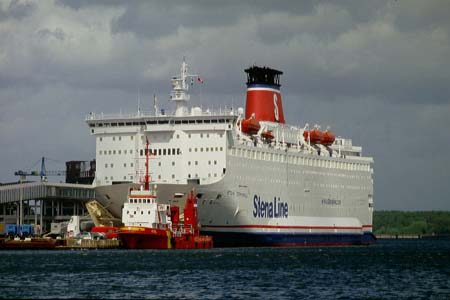
"Stena Germanica" bound for Gothenburg, Kiel 2007 (WS)
|
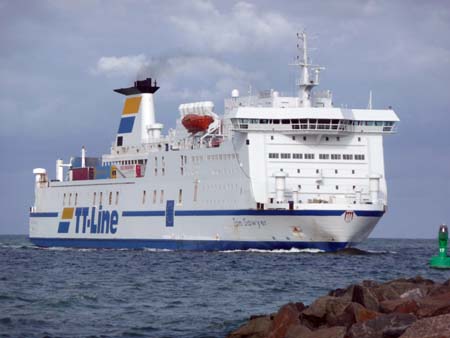
"Tom Sawyer" of TT-Line, Warnemuende 2009 (Norbert Kaiser, via Wikimedia)
|
Other Routes
Hi-speed catamarans were considered suitable for short Kattegat routes. The Cat-Link hi-speeds "Cat-Link I" and II of InCat and "Cat-Link III" of Austal were replaced from 1998 by the "Cat-Link IV" and "Cat-Link V" of the InCat-91 type, managed by Scandlines, from 1999 owned by Mols-Linien. Most famous became the record-breaking "Cat-Link V", then "Mads Mols", causing losses however and given away.
A quite different matter are the overnight cruises from Stockholm to the Aland Islands, a Finnish territory exempted from alcohol market restrictions, started in 1971 by Alandslinjen, the later Birka Line, with the "Baronessan" and sister "Prinsessan" (a DFDS vintage). In 1977 a new "Prinsessan" (ex "Finnhansa", in 1987 sold to Louis Cruise Lines as "Princesa Marissa") replaced the first one. After the "Birka Princess" and the beautiful cruise ship "Birka Queen" (the former "Royal Viking Sky", later becoming the "Boudicca" of Fred. Olsen Cruise Line), in 2004 the passenger-only "Birka Paradise" (34,728 gt) was introduced, giving reason to sell the "Birka Princess" to Louis Cruise Lines (renamed "Sea Diamond", she capsized at Santorini Island). In 2007 Birka became a subsidiary of Eckero.
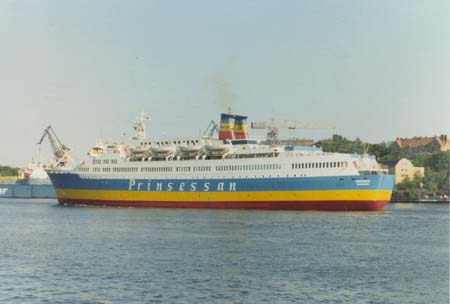
"Prinsessan" of Alands Linje, ex "Finnhansa", Stockholm 1982 (Maria Soelch)
|
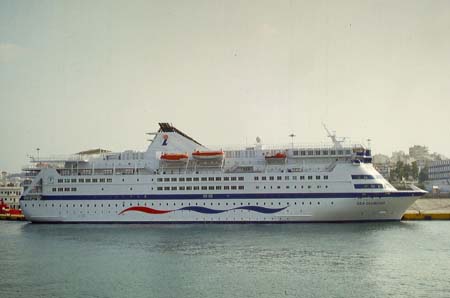
The former "Birka Princess" as "Sea Diamond" of Louis Cruise Lines, Piraeus 2006 (WS)
|
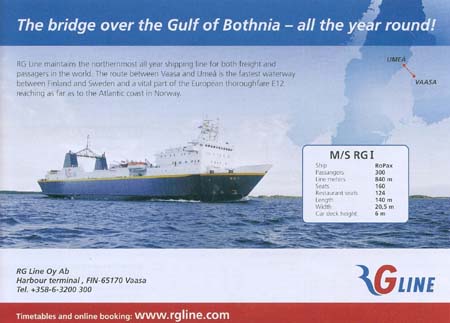 "RG I" on the Umea - Vaasa route (RG Line Oy Ab)
"RG I" on the Umea - Vaasa route (RG Line Oy Ab)
There are many services on shorter routes, e.g. Destination Gotland (in 1998 formed by N&T Gotlandslinjen and Silja Line), Bornholmstrafiken and local services connecting islands of Estonia. A tradition have also the northern routes to Finland across the Gulf of Bothnia, taken over by Silja Line and then by RG Line.
To Finland with Silja
Bore Line introduced in 1960 on the Stockholm - Turku route the conservative two-funnel steamer "Bore", described as a car ferry of c.3,400 gt (later "Borea", still in the 21st century cruising as MS "Kristina Regina" for Kristina Cruises, now preserved at Turku). In 1961 Silja Line, a jointly-owned subsidiary of FAA, Rederi AB Svea and Bore, opened a service from Norrtalje to Turku with the "Skandia". Norrtalje is a harbour north of Stockholm, connected with the capital by a small regional railway. Between Turku and Helsinki the Finnish railways are providing an efficient service shortening the shipping route.
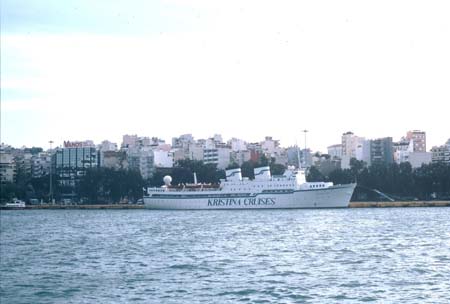
The former "Bore" as "Kristina Regina", Piraeus 2009 (WS)
|
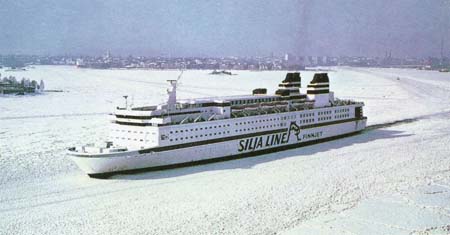
"Finnjet", ad of 1991 (Silja Line)
|
Between Germany and Finland, a service Travemuende - Hanko was started in 1962 by Finnlines OY (founded in 1947) with the "Hansa Express", followed by the "Helsinki Express" (the chartered "Nili", built for Somerfin Lines' intended services from Haifa) and then the newbuilds "Finnhansa" (1966/ 7,820 gt) with parallel funnels, sister "Finnpartner" and a new "Finnpartner" (ex "Saga", "Stena Atlantica"). Later Poseidon Lines, FAA and United Baltic Corp. shared the Travemuende services. An attempt by TT-Line with a cruise ferry service to Helsinki and Leningrad failed.
A sensation was created by Finnlines with introduction of the "Finnjet" in 1977 on the Travemuende - Helsinki route. This 24,605-ton ship of a revolutionary design, built by Wartsila (then Aker Yards), the silhouette being inspired by artist Kimmo Kaivanto, powered by gas-turbines for a speed of 30.5 knots, was the biggest and fastest ferry of its time. Equipped with cabins for 1,532 passengers, restaurant, night-club and a conference center, she offered an unprecedented comfort. For slower and more economic passages at 18 knots a diesel-electric engine set was additionally installed in 1981. Finnlines was taken over in 1986 by Effoa and Johnson Line, the successor of FAA.
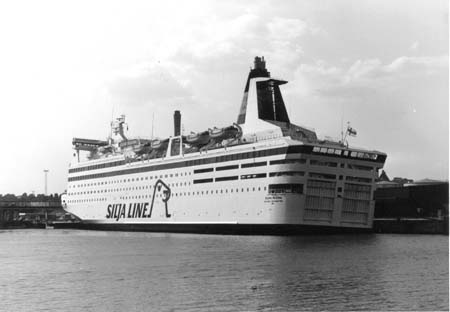
"Silvia Regina" bound for Helsinki, Stockholm Vartan 1982 (WS)
|
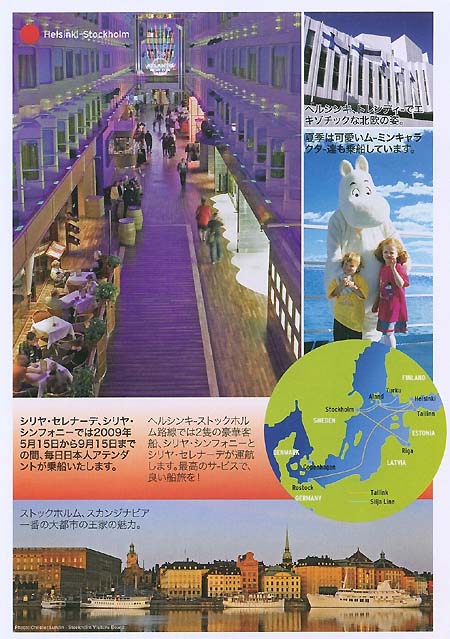
The promenade aboard "Silja Serenade" and "Silja Symphony" (Tallink Silja Line)
|
The Silja Line with their white/blue ships developed as a part of the renamed Effjohn-Trading AB of Helsinki, the FAA successor. As a result, the "Finnjet" operated for Silja Line, in 1994 a duck tail did rise the tonnage to 32,940 and the speed to 33.5 knots and from 1997 her story continued with the Tallinn route. The size of the "Finnjet" was exceeded with introduction of the 33,829-ton "Svea" (then "Silja Karneval", "Color Festival") and sister "Wellamo" (then "Silja Festival"). A sensation was the "Silja Serenade" (1990/58,376 gt) and her sister "Silja Symphony", employed on the Sweden - Finland route. They were renowned for their promenade-style shopping-mall, designed by Kai Levander and Harri Kulovaara, now the design feature of Royal Caribbean.
Troubled Silja Line together with the parent company, renamed Neptune Maritime, became in 1999 majority-owned by the Sea Containers Group of the American James B. Sherwood. In 2006 the insolvency of Sea Containers made headlines. Its subsidiary Silja Line was purchased by Tallink of Estonia, renamed Tallink Silja, preserving its identity (for the activities of Tallink see the paragraph Estonia). The 48,915-ton "Galaxy" of 2006, a 'cruiseferry' for 2,800 passengers and only 1,130 lanem, built by Aker Finyards for Tallink, was relocated to the traditional Stockholm - Helsinki route in 2008, being there the eyecatcher with her fanciful white/light-blue paint scheme.
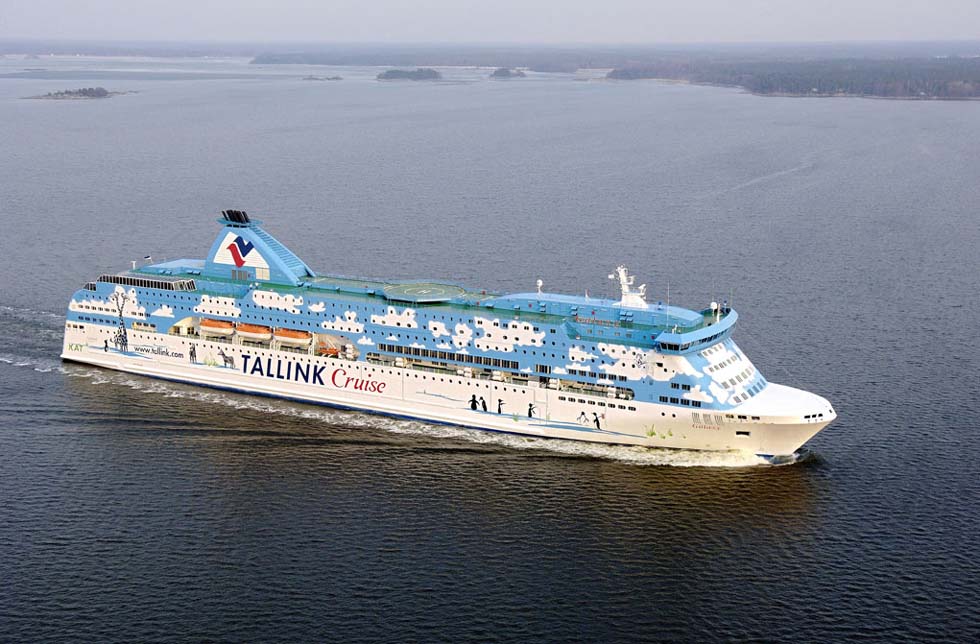
"Galaxy" of Tallink (Aker Finyards/STX Europe)
To Finland with Competitors
The Silja Line's start was followed in 1967 by Viking Line Kapellskar - Turku with the "Kapella". Vikinglinjen of the Aland islands and Rederi AB Slite were the predecessors, backed by Rederi AB Sally. The latter was taken over by Effjohn and its operations were absorbed into Silja Line. The Viking Line remained Silja's persevering competitor with red/white newbuids of c.35,000 tons. In 1989 Viking introduced the "Cinderella" (46,398 gt) on Stockholm - Finland services, showing art-deco styled interiors. That trend towards larger ferries led in 1993 to bankruptcy of Rederi AB Slite, partner of Viking Line. Their 59,914-ton "Europa" was completed in 1993 as "Silja Europa" for the competitor, while the 40,000-ton "Athena" and "Kalypso" were bought by Star Cruises of Malaysia. In 2010 Viking Line ordered at STX Europe a new 57,000-ton class with liquid gas propulsion, announced for Stockholm - Turku services, and in 2011 building the first vessel started at Turku.
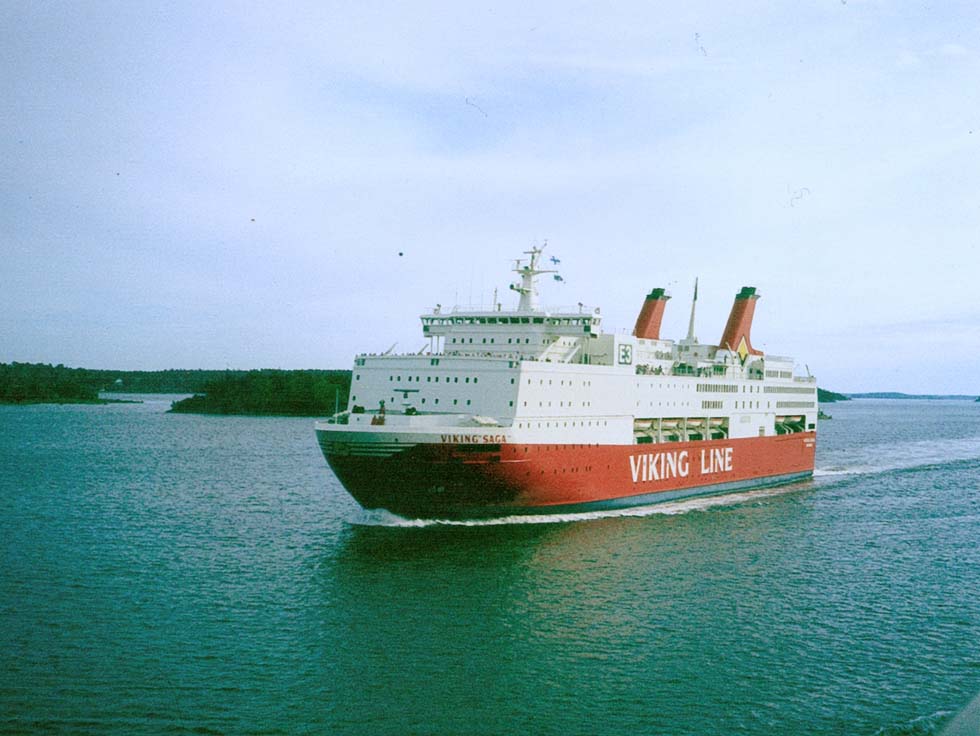
"Viking Saga" on the Stockholm - Alands route, 1982 (Hans Soelch sr)
Birka Line started in 1973 under the label Baltic Star Line a regular Stockholm - Helsinki service with the chartered "Freeport", joined by the "Drottningen" (of SJ), but it proved a failure.
On the route from Germany to Finland, Superfast Ferries of Greece opened a service in 2001. The "Superfast VII" and "Superfast VIII", 30,285-ton ferries built for a high speed around 30 knots, were introduced on the Rostock - Hanko route, followed by the "Superfast IX" and X. In 2006 the Baltic activities of overextended Superfast were purchased by Tallink from previous owner Attica Holdings. The ships retained their red/white livery, but their label changed to TALLINK and ownership to Tallink Superfast Ltd. The timetable listed the service Rostock - Helsinki by Tallink, but in 2011 the Superfast ferries were withdrawn and refurbished for Irish Sea services by Stena Line.
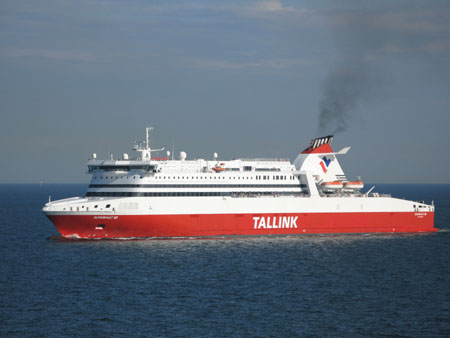
"Superfast VIII" of Tallink, near Helsinki 2007 (Oleg Popkov, via Wikimedia)
|
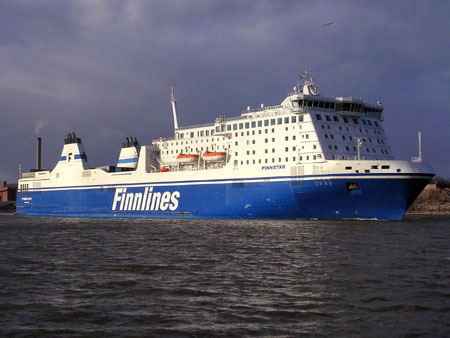
"Finnstar" departing Helsinki for Travemuende, 2007 (Kalle Id., via Wikimedia)
|
Finnlines with subsidiaries has changed more and more to ro-ro services. Nevertheless the blue-white "Finnstar" of 2006 and consorts with 4,200 lanem have accommodations also for 573 passengers, the public space being styled in a cool modern way. ShipPax 06 informed: "...Finnlines had benefitted greatly from opening up Russia". The modern ships were built in Italy and it's no wonder that the steadily expanding Grimaldi Group of Naples became the majority owner, holding in 2008 a 50.7 percent stake (according to wikipedia.org). In 2009 the "Nordlink" (2007/45,923 gt) of the Finnstar class changed from the Travemuende - Malmo route of subsidiary Nordo Link to the route Travemuende - Helsinki of Finnlines Deutschland.
Poland
Already during communist time, Poland was a refuge to cargo-train/truck ferries (passenger-train ferries are described with the relevant chapter). During many years Poland fought a persevering struggle against Soviet dictatorship, started in 1980 at Lenin shipyard by Lech Walesa. With the economic collapse of the Soviet Union, Germany became united, Poland was liberated and the three Baltic republics Lithuania, Latvia and Estonia were re-established in 1992. In 2004 these countries joined the EU.
The roots of Polferries as a state-owned enterprise go back to the year 1976.
Polska Zegluga Baltycka offered services from Swinoujscie (the former Swinemuende) to Copenhagen and from Gdansk (the former Danzig) to Helsinki. Although competed by other lines, the company survived under the label Polferries. Investment in a high-speed catamaran "Boomerang" however proved unsuccessful. Some other companies had a false start, e.g. Corona Line, which ceased operations in 1995. For a short time DFDS was operating a service to Gdansk. Initially with subsidiary Lion Ferry, Stena Line entered the market. Repositioning the "Stena Baltica" (1986/31,910 gt) in 2002 to the Karlskrona - Gdynia route, Stena Line became the leader in services to Poland.
Polferries operated routes from Swinoujscie to Copenhagen and from Gdansk to Nyneshamn (near Stockholm). In 2009 a restructuring of the state-owned institution was announced. The timetable of 2010 contained services to Nynashamn, to Ystad (near Trelleborg) and, with the "Pomerania", to Copenhagen.
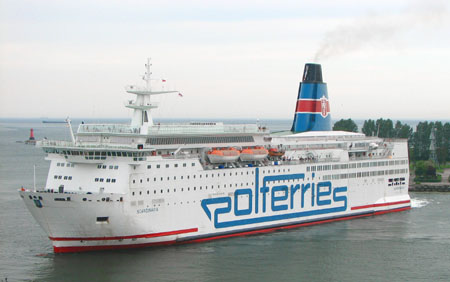
"Scandinavia" of Polferries, Gdansk 2006 (Brosen, via Wikimedia)
|
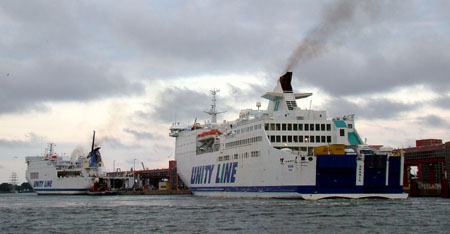
"Skania" of Unity Line, Swinoujscie 2009 (Mateusz War, via Wikimedia)
|
The Unity Line, initially intended as a new entity of the state-owned lines and now a member of Polstream Group, ameliorated the existing service between Swinoujscie and Ystad in 2008 with introduction of the "Skania" (1995/ 23,933 gt, ex "Superfast I", "Eurostar Roma"). Future became targeted by United Line with new vessels.
Lithuania and Latvia
Important for the Baltic republics are ro-ro services. Passenger traffic to Lithuania or Latvia has developed slowly. In 1986 cargo-train ferry services between Mukran on Ruegen island and Klaipeda (the former Memel) in Lithuania were introduced under Soviet leadership - see the relevant chapter. While in the new century passenger train services between Central Europe and the Baltic republics disappeared, the timetable listed ro-pax services by DFDS LISCO on the routes Kiel - Klaipeda, Karlshamn - Klaipeda and Travemuende - Riga (see also chapter Passenger Train Ferries/ Other Connections). Birka Line closed down a passenger service Stockholm - Riga. Also the ferry service of Riga Sea Line on this route disappeared from the timetable. Tallink established a service Stockholm - Riga, obviously more successful. In 2009 the "Regina Baltica" (1980/18,345 gt) was replaced on this route by the "Romantika" (2002/ 40,803 gt), a prestigious cruise ferry.
Estonia
In 1965, when the Baltics had been a part of the Soviet Union, state-owned ESCO (Estonian Shipping Co.) started a passenger service between Tallinn and Helsinki with the motor-ship "Vanemuine", followed in 1968 by the "Tallinn" and in 1980 by the "Georg Ots", one of the 12,000-ton passenger ships built in Poland during the '80s. In 1989, when the decline of the communist economy became evident, ESCO formed the subsidiary Tallink in cooperation with Finnish partners, introducing the "Tallink" (the former "Svea Regina") on the Helsinki - Tallinn route and then swallowing the competitor Estonian New Line. Also Viking, Silja Line, Eckero Line (ex Eestin Linjat) and for a short time around 1997 TH-Ferries appeared on the Tallinn route.
In 1990 EstLine of Estonia opened a Stockholm - Tallinn service. It became infamous with the catastrophe of the car-ferry "Estonia" (1980/ 15,567 gt, ex "Viking Sally", "Wasa King", "Silja Star") in 1994, killing 895 people. From the year 2000 ESCO was the sole owner of Estline.
In 1992 the Finnish partners abandoned Tallink and its ownership passed to Eminre, the renamed Hansatee, which (according to Bruce Peter) "had expanded too quickly (...), becoming indebted, and by the mid-1990s appeared to be heading for bankruptcy". Enn Pant of the Finance Ministry and Ain Hainschmidt of the creditor bank saved the firm, which in 2002 changed name into Tallink Group. The 39,864-ton cruise ferry "Romantika" from Aker Yards was Tallink's first newbuild, white with the red/blue ensign decorating the funnel. She was introduced on the Helsinki - Tallin route, surprising in consideration of her 2,172 berths in cabins and a travelling time of only 3 1/2 hours, but with an overnight stay on board it's a "mini-cruise". Sister "Victoria I" (2004/ 40,975 gt) was positioned on the 15 1/2 hour Stockholm - Tallinn route, opened in 2002 with the little "Fantaasia" (ex "Lion King" of Stena Line).
With acquisition of Silja Line in 2006 and takeover of Superfast's services and their extension to Tallinn in 2007, the Tallink Group became a main player in the Baltic Sea ferry business, surprising in consideration of Estonia's size with only 1.4 million inhabitants. In 2008 Tallink introduced the white/pink-painted cruise ferry "Baltic Princess" of 48,915 tons on the Helsinki - Tallinn route. Sisters, all built by Aker Yards/STX, are the "Romantika", "Victoria I" and "Galaxy", followed in 2009 by the "Baltic Queen", introduced on the Stockholm - Tallinn route. In 2007 the smaller, but faster light-green/white ro-pax "Star" (35,700 gt, 2,000 lanem, 27.7 knots) from Aker Yards and in 2008 the colourful Fincantieri-built 36,400-ton "Superstar" of Tallink Superfast started an additional Helsinki - Tallinn shuttle with a travelling time around 2 hours. Competitor Viking Line responded in 2008 with introduction of the 35,778-ton "Viking XPRS". In 2010 a letter of intent was signed with STX Europe for a 57,000-ton class.
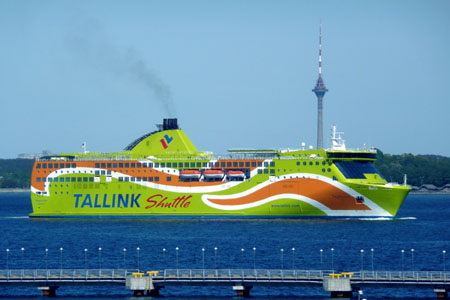
"Superstar", Helsinki - Tallinn shuttle, 2008 (Lisy, via Wikimedia)
|
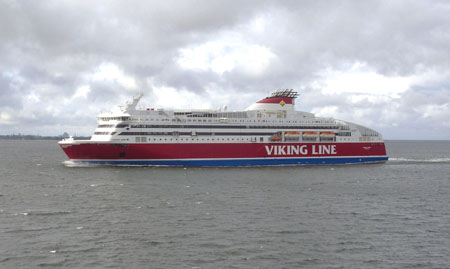
"Viking XPRS" from Helsinki arriving at Tallinn, 2008 (Alvar Lavague, via Wikimedia)
|
Hi-Speed to Estonia
The distance of only 48 nm between Helsinki and Tallinn has invited to introduce hi-speed services, connecting the two capitals in 100 minutes. Estonian New Line already had Kometa-type hydrofoils for Helsinki - Tallinn services. In 1994 the hydrofoils "Liisa" and "Laura" for 200 passengers were introduced under the Tallink Express brand, around 1996 sold to Linda Line. In 1997 Tallink introduced the catamaran "Tallink Express I", then the "Tallink Autoexpress" (ex "Cat-Link III") and in 2001 the catamaran "Tallink Autoexpress 2" (1997/5,307 gt). In 2004 followed the monohulls "Tallink Autoexpress 3" and 4, both of the 3,971-ton MDV1200-type of Fincantieri, (ex "Pegasus Two" and One), in 2007 sold to Arab Bridge Maritime as "Queen Nefertiti" resp. Aegean Speed Lines as "Speedrunner II". With only 90 minutes travelling time, the "Baltic Jet" and "Nordic Jet" of Nordic Jetline were even a little faster. During the icy winter season however, this company transferred its catamarans to FRS, operating in the Strait of Gibraltar, and in 2009 the Baltic route was abandoned.
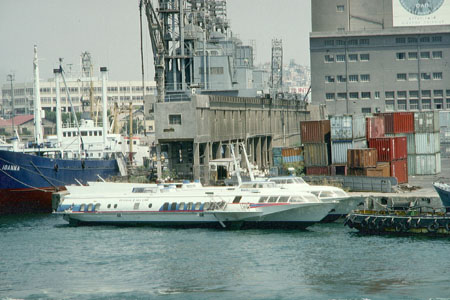
"Maarika" of Estonian New Line, transferred to Piraeus 1993 (WS)
|
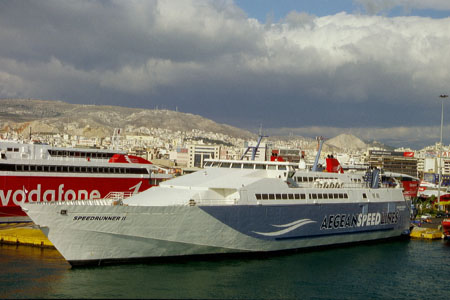
The former "Tallink Autoexpress 4" as "Speedrunner II" at Piraeus, 2007 (WS)
|
Silja Line, acquired by Sea Containers of James Sherwood, introduced in 2000 on the Helsinki - Tallinn route the enlarged Fincantieri MDV1200-type monohull "SuperSeaCat Four", later followed by sister "SuperSeaCat Three", transferred from the Channel. In 2005 the "SuperSeaCat One" was transferred from the Channel to Helsinki - Tallinn. Sherwood had to sell Silja Line in 2005-06. As Silja's new owner Tallink employed already a number of hi-speeds sufficient for this route, Sea Containers Finland continued to employ "SuperSeaCat Three" and Four on the Helsinki - Tallinn route. "SuperSeaCat One" became the "Almudaina Dos" of Trasmediterranea. A 50-percent share in the SuperSeaCat activities was acquired in 2008 by the Eugenides family of Greece, owner of Aegean Speed Lines. At that time the car-carrying hi-speeds of that route were well occupied and on the return trip the cars were charged with loads of alcohol, caused by the Finnish prohibition laws, so reported by a crew member. In October 2008 SuperSeaCat "went bankrupt" (according to Wikipedia) and from 2009 the "SuperSeaCat Three" and Four operated for Aegean Speed Lines in Greek waters (see chapter Aegean).
Helsinki - Tallinn services continued to be operated by Tallink, Viking Line, Eckero Line and Linda Line. Modern ro-pax ferries are with two hours travelling time not much slower than hi-speeds. A still faster link between Finland and Tallinn would be a railway tunnel. Indeed that idea was published after Estonia had joined the EU in 2004. However, it was an unrealistic dream, considering the finances. In 2010 the press (An Bord) reported a 1.2 billion euro debt of Tallink, but Lloyd's List could confirm a 18-percent rise in traffic.
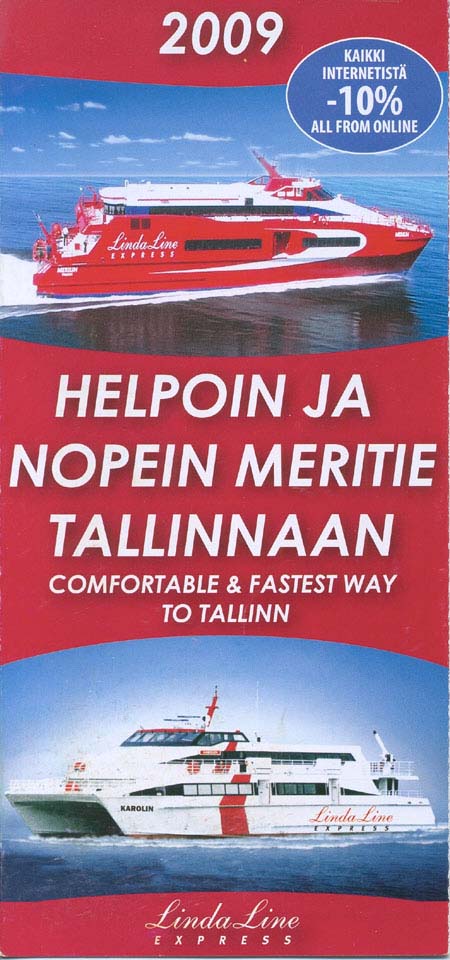 "Merilin" and "Karolin", Helsinki - Tallinn (Linda Line Express)
"Merilin" and "Karolin", Helsinki - Tallinn (Linda Line Express)
Russia
From the 60s the Soviet Union introduced the "Mikhail Kalinin" and similar passenger ships of c. 5,200 gt, built at Wismar in East Germany, equipped with West German MAN diesel engines. The Baltic Shipping Co. employed them in the 70s on Leningrad - London and Leningrad - Helsinki - Stockholm services. Between Stockholm and Leningrad, the "Ilyitch" (1973/ 8,528 gt, ex "Bore I", "Skandia", "Stena Baltica") of the Baltic Shipping Co. provided a service from 1984. Passenger traffic from Germany and the Baltics to Leningrad was handled by Soviet trains.
With the end of the Soviet Union, Leningrad became once more St. Petersburg. The "Anna Karenina" (ex "Viking Song", "Braemar") was introduced in 1991 on Kiel - St. Petersburg services under the label Baltic Express Line. The "Konstantin Simonov" of the 12,000-ton class, built in Poland, became employed in 1995 on a short-term St. Petersburg - Helsinki service. Also a Stockholm - St. Petersburg route by Ferry Service with her sisters "Konstantin Chernenko" and "Mikhail Sholokhov" was closed down soon (after a Vladivostok adventure the latter cruised for some time as "Ugo Foscolo" between Piraeus and Zakynthos). Neither an interlude by their sister "Mikhail Suslov" as the casino ship "Ocean Jewel of St. Petersburg" proved successful. James Sherwood targeted to expand to Russia and in 2004 St. Petersburg was connected with Rostock by the "Finnjet" of his Silja Line. The service ended soon (the famous ship was laid up and in 2005, after the hurricane Katrina, the "Finnjet" was chartered by the Louisiana State University and in 2008 she was scrapped at Alang). Also a Helsinki - Tallinn - St. Petersburg service of Tallink in 2004-05 with the small "Fantaasia" proved unsuccessful. In 2009 the newcomer Stella Line started a Helsinki - St. Petersburg service and closed it down in the same year. In 2010 the St. Peter Line of Russian-owned St. Petersburg Shipping entered the market with the "Princess Maria" (1981/ 25,905gt, ex "Finnlandia" of Silja Line, from 1990 "Queen of Scandinavia" of DFDS) on the Helsinki - St. Petersburg route. In 2011 the "Princesse Anastasia", acquired from the Irish Continental Group, opened the Stockholm - St. Petersburg route. The "Princesse Anastasia" (1986/ 37,799gt) is the former "Olympia" of Viking Line, then "Pride of Bilbao" of P&O. Adding services from Kiel together with Tallink and the "Regina Baltica" were rumoured.
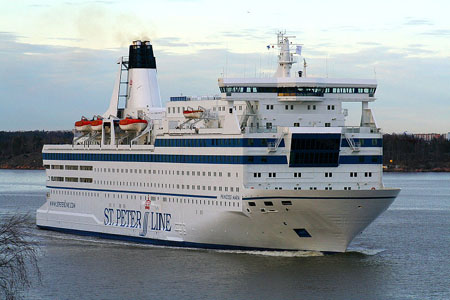 "Princess Maria" of St. Peter Line outside Helsinki, 2010 (Kalle Id, via Wikimedia)
"Princess Maria" of St. Peter Line outside Helsinki, 2010 (Kalle Id, via Wikimedia)
Apart from St. Petersburg, only the Oblast Kaliningrad, what once had been the German province East Prussia with the capital Koenigsberg, remained in Russian hands. From 2003 the "Georg Ots", the first of the Polish-built motor-ships, now owned by St. Petersburg Shipping, provided a regular service between St. Petersburg and the Oblast. It enabled passengers to undertake the journey without crossing Lithuania by train.
Developing services to St. Petersburg for trucks and trailers became a target, facing the notorious holdups of trucks in Eastern Europe during the years immediately after the 'Iron Curtain' was opened. In consideration of Grimaldi's participation in Finnlines, ShipPax 06 supposed that "...its TransRussia service is also needing larger, high iceclass ro-pax vessels". The "Translubeca" (1990/24,727 gt), in 2000 acquired by Finnlines, opened in 2003 the Luebeck - Sassnitz - St. Petersburg service. Though it is a ro-ro route, operator TransRussia Express offered the service also to passengers. The "Transeuropa" (1995/ 32,534 gt) changed in 2009 from the Travemuende - Helsinki route, like her sister "Transrussia" sporting the Finnlines label.
With takeover of the shipyards at Wismar and Rostock-Warnemuende, hopes arose that also Russia is to position itself on the ro-ro or ro-pax market. After bankruptcy of these Wadan shipyards and takeover by Gazprom boss Igor Yussufov (Der Spiegel 37/2009) as Nordic Yards, completion of world's largest ro-pax ferries for Stena Line continued. Initially they had been intended for Karlskrona - Gdynia and Harwich - Hoek services, but both were introduced on the Hoek van Holland route.
|